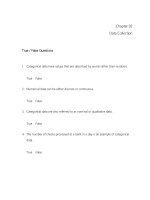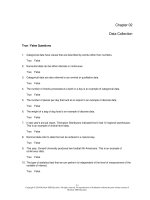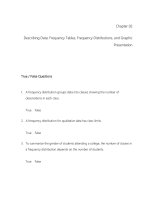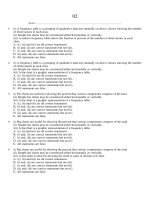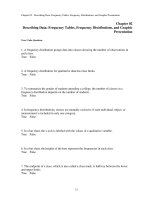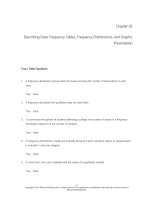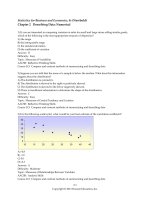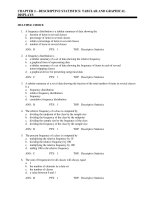Applied statistics in business and economics 5th edition doane test bank
Bạn đang xem bản rút gọn của tài liệu. Xem và tải ngay bản đầy đủ của tài liệu tại đây (457.96 KB, 49 trang )
Chapter 02
Data Collection
True / False Questions
1. Categorical data have values that are described by words rather than numbers.
True
False
2. Numerical data can be either discrete or continuous.
True
False
3. Categorical data are also referred to as nominal or qualitative data.
True
False
4. The number of checks processed at a bank in a day is an example of categorical data.
True
False
5. The number of planes per day that land at an airport is an example of discrete data.
True
False
6. The weight of a bag of dog food is an example of discrete data.
True
False
7. In last year's annual report, Thompson Distributors indicated that it had 12 regional warehouses.
This is an example of ordinal level data.
True
False
8. Nominal data refer to data that can be ordered in a natural way.
True
False
9. This year, Oxnard University produced two football All-Americans. This is an example of
continuous data.
True
False
10. The type of statistical test that we can perform is independent of the level of measurement of the
variable of interest.
True
False
2-1
Copyright © 2016 McGraw-Hill Education. All rights reserved. No reproduction or distribution without the prior written consent of
McGraw-Hill Education.
11. Your weight recorded at your annual physical would not be ratio data, because you cannot have
zero weight.
True
False
12. The level of measurement for categorical data is nominal.
True
False
13. Temperature measured in degrees Fahrenheit is an example of interval data.
True
False
14. The closing price of a stock is an example of ratio data.
True
False
15. The Statistical Abstract of the United States is a huge annual compendium of data for the United
States, and it is available online free of charge.
True
False
16. Ordinal data can be treated as if it were nominal data but not vice versa.
True
False
17. Responses on a seven-point Likert scale are usually treated as ratio data.
True
False
18. Likert scales are especially important in opinion polls and marketing surveys.
True
False
19. Ordinal data are data that can be ranked based on some natural characteristic of the items.
True
False
20. Ratio data are distinguished from interval data by the presence of a zero reference point.
True
False
21. It is better to attempt a census of a large population instead of relying on a sample.
True
False
22. Judgment sampling and convenience sampling are nonrandom sampling techniques.
True
False
23. A problem with judgment sampling is that the sample may not reflect the population.
True
False
2-2
Copyright © 2016 McGraw-Hill Education. All rights reserved. No reproduction or distribution without the prior written consent of
McGraw-Hill Education.
24. When the population is large, a sample estimate is usually preferable to a census.
True
False
25. Sampling error is avoidable by choosing the sample scientifically.
True
False
26. A sampling frame is used to identify the target population in a statistical study.
True
False
27. By taking a systematic sample, in which we select every 50th shopper arriving at a specific store,
we are approximating a random sample of shoppers.
True
False
28. A worker collecting data from every other shopper who leaves a store is taking a simple random
sample of customer opinion.
True
False
29. Creating a list of people by taking the third name listed on every 10 th page of the phone book is
an example of convenience sampling.
True
False
30. Internet surveys posted on popular websites have no bias since anyone can reply.
True
False
31. Analysis of month-by-month changes in stock market prices during the most recent recession
would require the use of time series data.
True
False
32. A cluster sample is a type of stratified sample that is based on geographical location.
True
False
33. An advantage of a systematic sample is that no list of enumerated data items is required.
True
False
34. Telephone surveys often have a low response rate and fail to reach the desired population.
True
False
35. Mail surveys are attractive because of their high response rates.
True
False
36. A problem with convenience sampling is that the target population is not well defined.
True
False
2-3
Copyright © 2016 McGraw-Hill Education. All rights reserved. No reproduction or distribution without the prior written consent of
McGraw-Hill Education.
37. If you randomly sample 50 students about their favorite places to eat, the data collected would be
referred to as cross-sectional data.
True
False
38. The number of FedEx shipping centers in each of 50 cities would be ordinal level data.
True
False
39. Internet surveys posted on popular websites such as MSN.com suffer from nonresponse bias.
True
False
40. Different variables are usually shown as columns of a multivariate data set.
True
False
41. Each row in a multivariate data matrix is an observation (e.g., an individual response).
True
False
42. A bivariate data set has only two observations on a variable.
True
False
43. Running times for 3,000 runners in a 5k race would be a multivariate data set.
True
False
44. Running times for 500 runners in a 5k race would be a univariate data set.
True
False
45. A list of the salaries, ages, and years of experience for 50 CEOs is a multivariate data set.
True
False
46. The daily closing price of Apple stock over the past month would be a time series.
True
False
47. The number of words on 50 randomly chosen textbook pages would be cross-sectional data.
True
False
48. A Likert scale with an even number of scale points between "Strongly Agree" and "Strongly
Disagree" is intended to prevent "neutral" choices.
True
False
49. Private statistical databases (e.g., CRSP) are usually free.
True
False
2-4
Copyright © 2016 McGraw-Hill Education. All rights reserved. No reproduction or distribution without the prior written consent of
McGraw-Hill Education.
Multiple Choice Questions
50. An investment firm rates bonds for AardCo Inc. as "B+," while bonds of Deva Corp. are rated
"AA." Which level of measurement would be appropriate for such data?
A. Nominal
B. Ordinal
C. Interval
D. Ratio
51. Which variable is least likely to be regarded as ratio data?
A. Length of time required for a randomly chosen vehicle to cross a toll bridge (minutes)
B. Weight of a randomly chosen student (pounds)
C. Number of fatalities in a randomly chosen traffic disaster (persons)
D. Student's evaluation of a professor's teaching (Likert scale)
52. Which of the following is numerical data?
A. Your gender
B. The brand of cell phone you own
C. Whether you have an American Express card
D. The fuel economy (MPG) of your car
53. Measurements from a sample are called:
A. statistics.
B. inferences.
C. parameters.
D. variables.
54. Quantitative variables use which two levels of measurement?
A. Ordinal and ratio
B. Interval and ordinal
C. Nominal and ordinal
D. Interval and ratio
55. Temperature in degrees Fahrenheit is an example of a(n) __________ variable.
A. nominal
B. ordinal
C. interval
D. ratio
2-5
Copyright © 2016 McGraw-Hill Education. All rights reserved. No reproduction or distribution without the prior written consent of
McGraw-Hill Education.
56. Using a sample to make generalizations about an aspect of a population is called:
A. data mining.
B. descriptive statistics.
C. random sampling.
D. statistical inference.
57. Your telephone area code is an example of a(n) ____________ variable.
A. nominal
B. ordinal
C. interval
D. ratio
58. Which is least likely to be regarded as a ratio variable?
A. A critic's rating of a restaurant on a 1 to 4 scale
B. Automobile exhaust emission of nitrogen dioxide (milligrams per mile)
C. Number of customer complaints per day at a cable TV company office
D. Cost of an eBay purchase
59. Automobile exhaust emission of CO2 (milligrams per mile) is ____________ data.
A. nominal
B. ordinal
C. interval
D. ratio
60. Your rating of the food served at a local restaurant using a three-point scale of 0 = gross, 1 =
decent, 2 = yummy is ___________ data.
A. nominal
B. ordinal
C. interval
D. ratio
61. The number of passengers "bumped" on a particular airline flight is ____________ data.
A. nominal
B. ordinal
C. interval
D. ratio
2-6
Copyright © 2016 McGraw-Hill Education. All rights reserved. No reproduction or distribution without the prior written consent of
McGraw-Hill Education.
62. Which should not be regarded as a continuous random variable?
A. Tonnage carried by a randomly chosen oil tanker at sea
B. Wind velocity at 7 o'clock this morning
C. Number of personal fouls by the Miami Heat in a game
D. Length of time to play a Wimbledon tennis match
63. Which of the following is not true?
A. Categorical data have values that are described by words rather than numbers.
B. Categorical data are also referred to as nominal or qualitative data.
C. The number of checks processed at a bank in a day is categorical data.
D. Numerical data can be either discrete or continuous.
64. Which of the following is true?
A. The type of charge card used by a customer (Visa, MasterCard, AmEx) is ordinal data.
B. The duration (minutes) of a flight from Boston to Minneapolis is ratio data.
C. The number of Nobel Prize-winning faculty at Oxnard University is continuous data.
D. The number of regional warehouses owned by Jankord Industries is ordinal data.
65. Which statement is correct?
A. Judgment sampling is preferred to systematic sampling.
B. Sampling without replacement introduces bias in our estimates of parameters.
C. Cluster sampling is useful when strata characteristics are unknown.
D. Focus groups usually work best without a moderator.
66. A Likert scale:
A. yields interval data if scale distances are equal.
B. must have an odd number of scale points.
C. must have a verbal label on each scale point.
D. is rarely used in marketing surveys.
67. Which is most nearly correct regarding sampling error?
A. It can be eliminated by increasing the sample size.
B. It cannot be eliminated by any statistical sampling method.
C. It can be eliminated by using Excel's =RANDBETWEEN() function.
D. It can be eliminated by utilizing systematic random sampling.
2-7
Copyright © 2016 McGraw-Hill Education. All rights reserved. No reproduction or distribution without the prior written consent of
McGraw-Hill Education.
68. Which statement is false?
A. Random dialing phone surveys have low response and are poorly targeted.
B. Selection bias means that many respondents dislike the interviewer.
C. Simple random sampling requires a list of the population.
D. Web surveys are economical but suffer from nonresponse bias.
69. Judgment sampling is sometimes preferred over random sampling, for example, when:
A. the desired sample size is much larger than the population.
B. the sampling budget is large and the population is conveniently located.
C. time is short and the sampling budget is limited.
D. the population is readily accessible and sampling is nondestructive.
70. An advantage of convenience samples is that:
A. the required sample size is easier to calculate.
B. sampling error can be reduced.
C. computation of statistics is easier.
D. they are often quicker and cheaper.
71. Before deciding whether to assess heavy fines against noisy airlines, which sampling method
would the Federal Aviation Administration probably use to measure the peak noise from departing
jets as measured by a ground-level observer at a point one mile from the end of the departure
runway?
A. Radio survey of pilots.
B. Simple random sample.
C. Judgment sample.
D. Stratified sample.
72. Professor Hardtack chose a sample of 7 students from his statistics class of 35 students by
picking every student who was wearing red that day. Which kind of sample is this?
A. Simple random sample
B. Judgment sample
C. Systematic sample
D. Convenience sample
73. Thirty work orders are selected from a filing cabinet containing 500 work order folders by
choosing every 15th folder. Which sampling method is this?
A. Simple random sample
B. Systematic sample
C. Stratified sample
D. Cluster sample
2-8
Copyright © 2016 McGraw-Hill Education. All rights reserved. No reproduction or distribution without the prior written consent of
McGraw-Hill Education.
74. Which of the following is not a likely reason for sampling?
A. The destructive nature of certain tests
B. The physical impossibility of checking all the items in the population
C. Prohibitive cost of studying the entire population
D. The expense of obtaining random numbers
75. Comparing a census of a large population to a sample drawn from it, we expect that the:
A. sample is usually a more practical method of obtaining the desired information.
B. accuracy of the observations in the census is surely higher than in the sample.
C. sample must be a large fraction of the population to be accurate.
76. A stratified sample is sometimes recommended when:
A. the sample size is very large.
B. the population is small compared to the sample.
C. distinguishable strata can be identified in the populations.
D. the population is spread out geographically.
77. A random sample is one in which the:
A. probability that an item is selected for the sample is the same for all population items.
B. population items are selected haphazardly by experienced workers.
C. items to be selected from the population are specified based on expert judgment.
D. probability of selecting a population item depends on the item's data value.
78. An advantage of convenience samples over random samples is that:
A. they are easy to analyze.
B. it is easier to determine the sample size needed.
C. it is easier to calculate the sampling errors involved.
D. data collection cost is reduced.
79. To measure satisfaction with its cell phone service, AT&T takes a stratified sample of its
customers by age, gender, and location. Which is an advantage of this type of sampling, as
opposed to other sampling methods?
A. It is less intrusive on customers' privacy.
B. It does not require random numbers.
C. It gives faster results.
D. It can give more accurate results.
2-9
Copyright © 2016 McGraw-Hill Education. All rights reserved. No reproduction or distribution without the prior written consent of
McGraw-Hill Education.
80. An accounting professor wishing to know how many MBA students would take a summer elective
in international accounting did a survey of the class she was teaching. Which kind of sample is
this?
A. Simple random sample
B. Cluster sample
C. Systematic sample
D. Convenience sample
81. A binary variable (also called a dichotomous variable or dummy variable) has:
A. only two possible values.
B. continuous scale values.
C. rounded data values.
D. ordinal or interval values.
82. A population has groups that have a small amount of variation within them, but large variation
among or between the groups themselves. The proper sampling technique is:
A. simple random.
B. stratified.
C. cluster.
D. judgment.
83. A manager chose two people from his team of eight to give an oral presentation because she felt
they were representative of the whole team's views. What sampling technique did she use in
choosing these two people?
A. Convenience
B. Simple random
C. Judgment
D. Cluster
84. Sampling bias can best be reduced by:
A. using appropriate data coding.
B. having a computer tabulate the results.
C. utilizing random sampling.
D. taking a judgment sample.
85. A sampling technique used when groups are defined by their geographical location is:
A. cluster sampling.
B. convenience sampling.
C. judgment sampling.
D. random sampling.
2-10
Copyright © 2016 McGraw-Hill Education. All rights reserved. No reproduction or distribution without the prior written consent of
McGraw-Hill Education.
86. If we choose 500 random numbers using Excel's function =RANDBETWEEN(1,99), we would
most likely find that:
A. numbers near the mean (50) would tend to occur more frequently.
B. numbers near 1 and 99 would tend to occur less frequently.
C. some numbers would occur more than once.
D. the numbers would have a clear pattern.
87. A problem with nonrandom sampling is that:
A. larger samples need to be taken to reduce the sampling error inherent in this approach.
B. not every item in the population has the same chance of being selected, as it should.
C. it is usually more expensive than random sampling.
D. it generally provides lower response rates than random sampling.
88. From its 32 regions, the FAA selects 6 regions, and then randomly audits 25 departing
commercial flights in each region for compliance with legal fuel and weight requirements. This is
an example of:
A. simple random sampling.
B. stratified random sampling.
C. cluster sampling.
D. judgment sampling.
89. Which of the following is a correct statement?
A. Choosing the third person listed on every fifth page of the phone book is stratified sampling.
B. An advantage of a systematic sample is that no list of enumerated data items is required.
C. Convenience sampling is used to study shoppers in convenience stores.
D. Judgment sampling is an example of true random sampling.
90. Which of the following is false?
A. Sampling error is the difference between the true parameter and the sample estimate.
B. Sampling error is a result of unavoidable random variation in a sample.
C. A sampling frame is chosen from the target population in a statistical study.
D. The target population must first be defined by a full list or data file of all individuals.
91. When we are choosing a random sample and we do not place chosen units back into the
population, we are:
A. sampling with replacement.
B. sampling without replacement.
C. using a systematic sample.
D. using a voluntary sample.
2-11
Copyright © 2016 McGraw-Hill Education. All rights reserved. No reproduction or distribution without the prior written consent of
McGraw-Hill Education.
92. Which method is likely to be used by a journalism student who is casually surveying opinions of
students about the university's cafeteria food for an article that she is writing?
A. Simple random sample
B. Systematic random sample
C. Cluster sample
D. Convenience sample
93. Which of the following is false?
A. Mail surveys are cheap but have low response rates.
B. Coverage error is when respondents give untruthful answers.
C. Focus groups are nonrandom but can probe issues more deeply.
D. Surveys posted on popular websites suffer from selection bias.
94. Which is a time series variable?
A. VISA balances of 30 students on December 31 of this year
B. Net earnings reported by Xena Corp. for the last 10 quarters
C. Dollar exchange rates yesterday against 10 other world currencies
D. Titles of the top 10 movies in total revenue last week
95. An observation in a data set would refer to:
A. only a variable whose value is recorded by visual inspection.
B. a data item whose value is numerical (as opposed to categorical).
C. a single row that contains one or more observed variables.
D. the values of all the variables in the entire data set.
96. A multivariate data set contains:
A. more than two observations.
B. more than two categorical variables.
C. more than two variables.
D. more than two levels of measurement.
97. The Centers for Disease Control and Prevention (CDC) wants to estimate the average extra
hospital stay that occurs when heart surgery patients experience postoperative atrial fibrillation.
They divide the United States into nine regions. In each region, hospitals are selected at random
within each hospital size group (small, medium, large). In each hospital, heart surgery patients
are sampled according to known percentages by age group (under 50, 50 to 64, 65 and over) and
gender (male, female). This procedure combines which sampling methods?
A. Systematic, simple random, and convenience
B. Convenience, systematic, and judgment
C. Cluster, stratified, and simple random
D. Judgment, systematic, and simple random
2-12
Copyright © 2016 McGraw-Hill Education. All rights reserved. No reproduction or distribution without the prior written consent of
McGraw-Hill Education.
98. Which statement is correct?
A. Selecting every fifth shopper arriving at a store will approximate a random sample of shoppers.
B. Selecting only shoppers who drive SUVs is a stratified sampling method.
C. A census is preferable to a sample for most business problems.
D. Stratified samples are usually cheaper than other methods.
99. Which is a categorical variable?
A. The brand of jeans you usually wear
B. The price you paid for your last pair of jeans
C. The distance to the store where you purchased your last pair of jeans
D. The number of pairs of jeans that you own
100.Which is a discrete variable?
A. The time it takes to put on a pair of jeans
B. The price you paid for your last pair of jeans
C. The distance to the store where you purchased your last pair of jeans
D. The number of pairs of jeans that you own
101.A section of the population we have targeted for analysis is:
A. a statistic.
B. a frame.
C. a sample.
D. a coven.
102.Which is not a time series variable?
A. Closing checkbook balances of 30 students on December 31 of this year
B. Net earnings reported by Xena Corp. for the last 10 quarters
C. Dollar/euro exchange rates at 12 noon GMT for the last 30 days
D. Movie attendance at a certain theater for each Saturday last year
103.A good Likert scale may not have:
A. unequal distances between scale points.
B. an odd number of scale points.
C. a verbal label on each scale point.
D. verbal anchors at its end points.
2-13
Copyright © 2016 McGraw-Hill Education. All rights reserved. No reproduction or distribution without the prior written consent of
McGraw-Hill Education.
104.A Likert scale with an odd number of scale points between "Strongly Agree" and "Strongly
Disagree":
A. cannot have equal scale distances.
B. cannot have a neutral middle point.
C. must have a verbal label on each scale point.
D. is often used in marketing surveys.
105.A Likert scale with an even number of scale points between "Strongly Agree" and "Strongly
Disagree":
A. cannot have equal scale distances.
B. is intended to prevent "neutral" choices.
C. must have a verbal label on each scale point.
D. is rarely used in surveys.
106.Which statement is correct?
A. Analysts rarely consult business periodicals (e.g., Bloomberg Businessweek).
B. Web searches (e.g., Google) often yield unverifiable data.
C. Government data sources (e.g., www.bls.gov) are often costly.
D. Private statistical databases (e.g., CRSP) are usually free.
107.Which statement is correct?
A. Analysts avoid business periodicals (e.g., Bloomberg Businessweek).
B. Web searches (e.g., Google) yield reliable and easily verified data.
C. Government data sources (e.g., www.bls.gov) usually are free.
D. Private statistical databases (e.g., CRSP) usually are free.
Short Answer Questions
108.Which survey method would you recommend to survey opinions of airline passengers about the
cleanliness of the restrooms in the Detroit airport? Why not the others?
2-14
Copyright © 2016 McGraw-Hill Education. All rights reserved. No reproduction or distribution without the prior written consent of
McGraw-Hill Education.
109.What kind of sampling method would you suggest in order to tabulate the number of formulas on
a typical page of the Doane-Seward textbook? Defend your choice.
110.How would you design a study to see whether drivers using hands-free cell phones are distracted
enough to slow their reactions to emergency situations? How would you collect data?
111.Explain the concept of a focus group. In what ways does a focus group resemble a survey? Why
is a moderator desirable? What else is required to make a successful focus group?
2-15
Copyright © 2016 McGraw-Hill Education. All rights reserved. No reproduction or distribution without the prior written consent of
McGraw-Hill Education.
Chapter 02 Data Collection Answer Key
True / False Questions
1.
Categorical data have values that are described by words rather than numbers.
TRUE
Categories are nominal data but could also be ranked (e.g., sophomore, junior, senior).
Accessibility: Keyboard Navigation
Blooms: Remember
Difficulty: 1 Easy
Learning Objective: 02-02 Explain the difference between numerical and categorical data.
Learning Objective: 02-09 Describe basic elements of survey types, survey designs, and response scales.
Topic: Variables and Data
2.
Numerical data can be either discrete or continuous.
TRUE
Numerical data can be counts (e.g., cars owned) or continuous scales (e.g., height).
Accessibility: Keyboard Navigation
Blooms: Remember
Difficulty: 1 Easy
Learning Objective: 02-02 Explain the difference between numerical and categorical data.
Learning Objective: 02-09 Describe basic elements of survey types, survey designs, and response scales.
Topic: Variables and Data
3.
Categorical data are also referred to as nominal or qualitative data.
TRUE
Categories are nominal data (nonnumerical), sometimes called qualitative data.
Accessibility: Keyboard Navigation
Blooms: Remember
Difficulty: 1 Easy
Learning Objective: 02-02 Explain the difference between numerical and categorical data.
Learning Objective: 02-09 Describe basic elements of survey types, survey designs, and response scales.
Topic: Variables and Data
4.
The number of checks processed at a bank in a day is an example of categorical data.
FALSE
Integers are actually numerical data.
Accessibility: Keyboard Navigation
Blooms: Apply
Difficulty: 1 Easy
2-16
Copyright © 2016 McGraw-Hill Education. All rights reserved. No reproduction or distribution without the prior written consent of
McGraw-Hill Education.
Learning Objective: 02-02 Explain the difference between numerical and categorical data.
Learning Objective: 02-09 Describe basic elements of survey types, survey designs, and response scales.
Topic: Variables and Data
5.
The number of planes per day that land at an airport is an example of discrete data.
TRUE
Integers are discrete numerical data.
Accessibility: Keyboard Navigation
Blooms: Apply
Difficulty: 1 Easy
Learning Objective: 02-02 Explain the difference between numerical and categorical data.
Learning Objective: 02-09 Describe basic elements of survey types, survey designs, and response scales.
Topic: Variables and Data
6.
The weight of a bag of dog food is an example of discrete data.
FALSE
Weight is measured on a continuous scale.
Accessibility: Keyboard Navigation
Blooms: Apply
Difficulty: 1 Easy
Learning Objective: 02-02 Explain the difference between numerical and categorical data.
Learning Objective: 02-09 Describe basic elements of survey types, survey designs, and response scales.
Topic: Variables and Data
7.
In last year's annual report, Thompson Distributors indicated that it had 12 regional
warehouses. This is an example of ordinal level data.
FALSE
"Number of" is a count, which is ratio data because a zero exists (better than ordinal).
Accessibility: Keyboard Navigation
Blooms: Apply
Difficulty: 1 Easy
Learning Objective: 02-04 Recognize levels of measurement in data and ways of coding data.
Learning Objective: 02-09 Describe basic elements of survey types, survey designs, and response scales.
Topic: Level of Measurement
8.
Nominal data refer to data that can be ordered in a natural way.
FALSE
Nominal (categorical) data would be called ordinal only if categories can be ranked.
Accessibility: Keyboard Navigation
Blooms: Remember
Difficulty: 1 Easy
Learning Objective: 02-04 Recognize levels of measurement in data and ways of coding data.
Learning Objective: 02-09 Describe basic elements of survey types, survey designs, and response scales.
Topic: Level of Measurement
2-17
Copyright © 2016 McGraw-Hill Education. All rights reserved. No reproduction or distribution without the prior written consent of
McGraw-Hill Education.
9.
This year, Oxnard University produced two football All-Americans. This is an example of
continuous data.
FALSE
The "number of" anything is discrete.
Accessibility: Keyboard Navigation
Blooms: Apply
Difficulty: 1 Easy
Learning Objective: 02-02 Explain the difference between numerical and categorical data.
Learning Objective: 02-09 Describe basic elements of survey types, survey designs, and response scales.
Topic: Variables and Data
10.
The type of statistical test that we can perform is independent of the level of measurement of
the variable of interest.
FALSE
Some statistical operations are restricted unless you have ratio or interval data.
Accessibility: Keyboard Navigation
Blooms: Understand
Difficulty: 1 Easy
Learning Objective: 02-04 Recognize levels of measurement in data and ways of coding data.
Learning Objective: 02-09 Describe basic elements of survey types, survey designs, and response scales.
Topic: Level of Measurement
11.
Your weight recorded at your annual physical would not be ratio data, because you cannot
have zero weight.
FALSE
Zero is only a reference point, not necessarily an observable data value.
Accessibility: Keyboard Navigation
Blooms: Apply
Difficulty: 2 Medium
Learning Objective: 02-04 Recognize levels of measurement in data and ways of coding data.
Learning Objective: 02-09 Describe basic elements of survey types, survey designs, and response scales.
Topic: Level of Measurement
12.
The level of measurement for categorical data is nominal.
TRUE
Categorical and nominal are equivalent terms.
Accessibility: Keyboard Navigation
Blooms: Remember
Difficulty: 1 Easy
Learning Objective: 02-04 Recognize levels of measurement in data and ways of coding data.
Learning Objective: 02-09 Describe basic elements of survey types, survey designs, and response scales.
Topic: Level of Measurement
2-18
Copyright © 2016 McGraw-Hill Education. All rights reserved. No reproduction or distribution without the prior written consent of
McGraw-Hill Education.
13.
Temperature measured in degrees Fahrenheit is an example of interval data.
TRUE
For temperature, scale distances are meaningful (20 to 25 is the same as 50 to 55 degrees),
and 0 degrees Fahrenheit does not mean the absence of heat, so it is not a ratio
measurement.
Accessibility: Keyboard Navigation
Blooms: Apply
Difficulty: 2 Medium
Learning Objective: 02-04 Recognize levels of measurement in data and ways of coding data.
Learning Objective: 02-09 Describe basic elements of survey types, survey designs, and response scales.
Topic: Level of Measurement
14.
The closing price of a stock is an example of ratio data.
TRUE
True zero exists as a reference, whether or not it is observed.
Accessibility: Keyboard Navigation
Blooms: Apply
Difficulty: 2 Medium
Learning Objective: 02-04 Recognize levels of measurement in data and ways of coding data.
Learning Objective: 02-09 Describe basic elements of survey types, survey designs, and response scales.
Topic: Level of Measurement
15.
The Statistical Abstract of the United States is a huge annual compendium of data for the
United States, and it is available online free of charge.
TRUE
A useful reference for business (e.g., for marketing, economics, or finance).
AACSB: Technology
Accessibility: Keyboard Navigation
Blooms: Remember
Difficulty: 1 Easy
Learning Objective: 02-08 Find everyday print or electronic data sources.
Topic: Data Sources
16.
Ordinal data can be treated as if it were nominal data but not vice versa.
TRUE
You can always go back to a lower level of measurement (but not vice versa).
Accessibility: Keyboard Navigation
Blooms: Understand
Difficulty: 1 Easy
Learning Objective: 02-04 Recognize levels of measurement in data and ways of coding data.
Learning Objective: 02-09 Describe basic elements of survey types, survey designs, and response scales.
Topic: Level of Measurement
2-19
Copyright © 2016 McGraw-Hill Education. All rights reserved. No reproduction or distribution without the prior written consent of
McGraw-Hill Education.
17.
Responses on a seven-point Likert scale are usually treated as ratio data.
FALSE
No true zero point exists on a Likert scale.
Accessibility: Keyboard Navigation
Blooms: Understand
Difficulty: 1 Easy
Learning Objective: 02-04 Recognize levels of measurement in data and ways of coding data.
Learning Objective: 02-09 Describe basic elements of survey types, survey designs, and response scales.
Topic: Level of Measurement
18.
Likert scales are especially important in opinion polls and marketing surveys.
TRUE
Likert scales are used in all kinds of surveys.
Accessibility: Keyboard Navigation
Blooms: Remember
Difficulty: 1 Easy
Learning Objective: 02-05 Recognize a Likert scale and know how to use it.
Learning Objective: 02-09 Describe basic elements of survey types, survey designs, and response scales.
Topic: Level of Measurement
19.
Ordinal data are data that can be ranked based on some natural characteristic of the items.
TRUE
For example, the eras Jurassic, Paleozoic, and Mesozoic can be ranked in time.
Accessibility: Keyboard Navigation
Blooms: Remember
Difficulty: 1 Easy
Learning Objective: 02-04 Recognize levels of measurement in data and ways of coding data.
Learning Objective: 02-09 Describe basic elements of survey types, survey designs, and response scales.
Topic: Level of Measurement
20.
Ratio data are distinguished from interval data by the presence of a zero reference point.
TRUE
The true zero is a reference that need not be observable.
Accessibility: Keyboard Navigation
Blooms: Remember
Difficulty: 2 Medium
Learning Objective: 02-04 Recognize levels of measurement in data and ways of coding data.
Learning Objective: 02-09 Describe basic elements of survey types, survey designs, and response scales.
Topic: Level of Measurement
2-20
Copyright © 2016 McGraw-Hill Education. All rights reserved. No reproduction or distribution without the prior written consent of
McGraw-Hill Education.
21.
It is better to attempt a census of a large population instead of relying on a sample.
FALSE
A census may founder on cost and time, while samples can be quick and accurate.
Accessibility: Keyboard Navigation
Blooms: Understand
Difficulty: 2 Medium
Learning Objective: 02-06 Use the correct terminology for samples and populations.
Learning Objective: 02-09 Describe basic elements of survey types, survey designs, and response scales.
Topic: Sampling Concepts
22.
Judgment sampling and convenience sampling are nonrandom sampling techniques.
TRUE
To be random, every item must have the same chance of being chosen.
Accessibility: Keyboard Navigation
Blooms: Remember
Difficulty: 1 Easy
Learning Objective: 02-07 Explain the common sampling methods and how to implement them.
Learning Objective: 02-09 Describe basic elements of survey types, survey designs, and response scales.
Topic: Sampling Methods
23.
A problem with judgment sampling is that the sample may not reflect the population.
TRUE
While better than mere convenience, judgment may still have flaws.
Accessibility: Keyboard Navigation
Blooms: Remember
Difficulty: 1 Easy
Learning Objective: 02-07 Explain the common sampling methods and how to implement them.
Learning Objective: 02-09 Describe basic elements of survey types, survey designs, and response scales.
Topic: Sampling Methods
24.
When the population is large, a sample estimate is usually preferable to a census.
TRUE
A census may founder on cost and time, while samples can be quick and accurate.
Accessibility: Keyboard Navigation
Blooms: Understand
Difficulty: 1 Easy
Learning Objective: 02-06 Use the correct terminology for samples and populations.
Learning Objective: 02-09 Describe basic elements of survey types, survey designs, and response scales.
Topic: Sampling Concepts
2-21
Copyright © 2016 McGraw-Hill Education. All rights reserved. No reproduction or distribution without the prior written consent of
McGraw-Hill Education.
25.
Sampling error is avoidable by choosing the sample scientifically.
FALSE
Sampling error is unavoidable, though it can be reduced by careful sampling.
Accessibility: Keyboard Navigation
Blooms: Remember
Difficulty: 2 Medium
Learning Objective: 02-07 Explain the common sampling methods and how to implement them.
Learning Objective: 02-09 Describe basic elements of survey types, survey designs, and response scales.
Topic: Sampling Methods
26.
A sampling frame is used to identify the target population in a statistical study.
TRUE
Only some portion of the population may be targeted (e.g., independent voters).
Accessibility: Keyboard Navigation
Blooms: Remember
Difficulty: 2 Medium
Learning Objective: 02-06 Use the correct terminology for samples and populations.
Learning Objective: 02-09 Describe basic elements of survey types, survey designs, and response scales.
Topic: Sampling Concepts
27.
By taking a systematic sample, in which we select every 50th shopper arriving at a specific
store, we are approximating a random sample of shoppers.
TRUE
There is no bias if this method is implemented correctly.
Accessibility: Keyboard Navigation
Blooms: Apply
Difficulty: 2 Medium
Learning Objective: 02-07 Explain the common sampling methods and how to implement them.
Learning Objective: 02-09 Describe basic elements of survey types, survey designs, and response scales.
Topic: Sampling Methods
28.
A worker collecting data from every other shopper who leaves a store is taking a simple
random sample of customer opinion.
FALSE
Not unless the target population is customers who shopped today (cf., all customers).
Accessibility: Keyboard Navigation
Blooms: Apply
Difficulty: 2 Medium
Learning Objective: 02-07 Explain the common sampling methods and how to implement them.
Learning Objective: 02-09 Describe basic elements of survey types, survey designs, and response scales.
Topic: Sampling Methods
2-22
Copyright © 2016 McGraw-Hill Education. All rights reserved. No reproduction or distribution without the prior written consent of
McGraw-Hill Education.
29.
Creating a list of people by taking the third name listed on every 10 th page of the phone book
is an example of convenience sampling.
FALSE
This resembles two-stage cluster sampling combined with systematic sampling.
Accessibility: Keyboard Navigation
Blooms: Apply
Difficulty: 2 Medium
Learning Objective: 02-07 Explain the common sampling methods and how to implement them.
Learning Objective: 02-09 Describe basic elements of survey types, survey designs, and response scales.
Topic: Sampling Methods
30.
Internet surveys posted on popular websites have no bias since anyone can reply.
FALSE
Self-selection bias exists (respondents may be atypical).
AACSB: Technology
Accessibility: Keyboard Navigation
Blooms: Understand
Difficulty: 2 Medium
Topic: Surveys
31.
Analysis of month-by-month changes in stock market prices during the most recent recession
would require the use of time series data.
TRUE
Data collected and recorded over time would be a time series.
Accessibility: Keyboard Navigation
Blooms: Apply
Difficulty: 2 Medium
Learning Objective: 02-03 Explain the difference between time series and cross-sectional data.
Learning Objective: 02-09 Describe basic elements of survey types, survey designs, and response scales.
Topic: Variables and Data
32.
A cluster sample is a type of stratified sample that is based on geographical location.
TRUE
For example, sampling voters randomly within random zip codes.
Accessibility: Keyboard Navigation
Blooms: Remember
Difficulty: 1 Easy
Learning Objective: 02-07 Explain the common sampling methods and how to implement them.
Learning Objective: 02-09 Describe basic elements of survey types, survey designs, and response scales.
Topic: Sampling Methods
2-23
Copyright © 2016 McGraw-Hill Education. All rights reserved. No reproduction or distribution without the prior written consent of
McGraw-Hill Education.
33.
An advantage of a systematic sample is that no list of enumerated data items is required.
TRUE
Systematic sampling works with a list (like random sampling) but also without one.
Accessibility: Keyboard Navigation
Blooms: Remember
Difficulty: 1 Easy
Learning Objective: 02-07 Explain the common sampling methods and how to implement them.
Learning Objective: 02-09 Describe basic elements of survey types, survey designs, and response scales.
Topic: Sampling Methods
34.
Telephone surveys often have a low response rate and fail to reach the desired population.
TRUE
Phone surveys are cheaper, but it is hard to avoid these problems.
Accessibility: Keyboard Navigation
Blooms: Remember
Difficulty: 1 Easy
Learning Objective: 02-09 Describe basic elements of survey types, survey designs, and response scales.
Topic: Surveys
35.
Mail surveys are attractive because of their high response rates.
FALSE
Mail surveys have low response rates and invite self-selection bias.
Accessibility: Keyboard Navigation
Blooms: Remember
Difficulty: 1 Easy
Learning Objective: 02-09 Describe basic elements of survey types, survey designs, and response scales.
Topic: Surveys
36.
A problem with convenience sampling is that the target population is not well defined.
TRUE
Convenience sampling is quick but not random, and the target population is unclear.
Accessibility: Keyboard Navigation
Blooms: Remember
Difficulty: 2 Medium
Learning Objective: 02-07 Explain the common sampling methods and how to implement them.
Learning Objective: 02-09 Describe basic elements of survey types, survey designs, and response scales.
Topic: Sampling Methods
2-24
Copyright © 2016 McGraw-Hill Education. All rights reserved. No reproduction or distribution without the prior written consent of
McGraw-Hill Education.
37.
If you randomly sample 50 students about their favorite places to eat, the data collected would
be referred to as cross-sectional data.
TRUE
Data for individuals would be a cross section (not a time series).
Accessibility: Keyboard Navigation
Blooms: Apply
Difficulty: 2 Medium
Learning Objective: 02-03 Explain the difference between time series and cross-sectional data.
Learning Objective: 02-09 Describe basic elements of survey types, survey designs, and response scales.
Topic: Variables and Data
38.
The number of FedEx shipping centers in each of 50 cities would be ordinal level data.
FALSE
The "number of" anything is ratio data because a true zero reference point exists.
Accessibility: Keyboard Navigation
Blooms: Apply
Difficulty: 2 Medium
Learning Objective: 02-04 Recognize levels of measurement in data and ways of coding data.
Learning Objective: 02-09 Describe basic elements of survey types, survey designs, and response scales.
Topic: Level of Measurement
39.
Internet surveys posted on popular websites such as MSN.com suffer from nonresponse bias.
TRUE
Nonresponse or self-selection bias is rampant in such surveys.
Accessibility: Keyboard Navigation
Blooms: Apply
Difficulty: 2 Medium
Learning Objective: 02-09 Describe basic elements of survey types, survey designs, and response scales.
Topic: Surveys
40.
Different variables are usually shown as columns of a multivariate data set.
TRUE
It is customary to use a column for each variable, while each row is an observation.
Accessibility: Keyboard Navigation
Blooms: Remember
Difficulty: 1 Easy
Learning Objective: 02-01 Use basic terminology for describing data and samples.
Learning Objective: 02-09 Describe basic elements of survey types, survey designs, and response scales.
Topic: Variables and Data
2-25
Copyright © 2016 McGraw-Hill Education. All rights reserved. No reproduction or distribution without the prior written consent of
McGraw-Hill Education.

